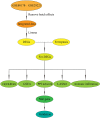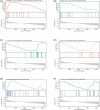Identification and verification of ferroptosis-related genes in diabetic foot using bioinformatics analysis
- PMID: 37249237
- PMCID: PMC10502281
- DOI: 10.1111/iwj.14198
Identification and verification of ferroptosis-related genes in diabetic foot using bioinformatics analysis
Abstract
Ferroptosis is a novel form of cell death that plays a key role in several diseases, including inflammation and tumours; however, the role of ferroptosis-related genes in diabetic foot remains unclear. Herein, diabetic foot-related genes were downloaded from the Gene Expression Omnibus and the ferroptosis database (FerrDb). The least absolute shrinkage and selection operator regression algorithm was used to construct a related risk model, and differentially expressed genes were analysed through immune infiltration. Finally, we identified relevant core genes through a protein-protein interaction network, subsequently verified using immunohistochemistry. Comprehensive analysis showed 198 genes that were differentially expressed during ferroptosis. Based on functional enrichment analysis, these genes were primarily involved in cell response, chemical stimulation, and autophagy. Using the CIBERSORT algorithm, we calculated the immune infiltration of 22 different types of immune cells in diabetic foot and normal tissues. The protein-protein interaction network identified the hub gene TP53, and according to immunohistochemistry, the expression of TP53 was high in diabetic foot tissues but low in normal tissues. Accordingly, we identified the ferroptosis-related gene TP53 in the diabetic foot, which may play a key role in the pathogenesis of diabetic foot and could be used as a potential biomarker.
Keywords: TP53; bioinformatics analysis; diabetic foot; ferroptosis; inflammatory reaction.
© 2023 The Authors. International Wound Journal published by Medicalhelplines.com Inc and John Wiley & Sons Ltd.
Conflict of interest statement
The authors declare that there is no conflict of interest.
Figures









Similar articles
-
Identification of hub ferroptosis-related genes and immune infiltration in lupus nephritis using bioinformatics.Sci Rep. 2022 Nov 5;12(1):18826. doi: 10.1038/s41598-022-23730-8. Sci Rep. 2022. PMID: 36335193 Free PMC article.
-
Novel ferroptosis gene biomarkers and immune infiltration profiles in diabetic kidney disease via bioinformatics.FASEB J. 2024 Jan 31;38(2):e23421. doi: 10.1096/fj.202301357RR. FASEB J. 2024. PMID: 38198194
-
Identification of Ferroptosis-Related Hub Genes and Their Association with Immune Infiltration in Chronic Obstructive Pulmonary Disease by Bioinformatics Analysis.Int J Chron Obstruct Pulmon Dis. 2022 May 24;17:1219-1236. doi: 10.2147/COPD.S348569. eCollection 2022. Int J Chron Obstruct Pulmon Dis. 2022. PMID: 35637927 Free PMC article.
-
Identification of Ferroptosis-related potential biomarkers and immunocyte characteristics in Chronic Thromboembolic Pulmonary Hypertension via bioinformatics analysis.BMC Cardiovasc Disord. 2023 Oct 11;23(1):504. doi: 10.1186/s12872-023-03511-5. BMC Cardiovasc Disord. 2023. PMID: 37821869 Free PMC article.
-
The role of programmed cell death in diabetic foot ulcers.Int Wound J. 2023 Sep 22;21(2):e14399. doi: 10.1111/iwj.14399. Online ahead of print. Int Wound J. 2023. PMID: 37736955 Free PMC article. Review.
Cited by
-
Repair and regeneration: ferroptosis in the process of remodeling and fibrosis in impaired organs.Cell Death Discov. 2024 Oct 2;10(1):424. doi: 10.1038/s41420-024-02181-2. Cell Death Discov. 2024. PMID: 39358326 Free PMC article. Review.
-
Underlying Mechanism of Traditional Herbal Formula Chuang-Ling-Ye in the Treatment of Diabetic Foot Ulcer through Network Pharmacology and Molecular Docking.Curr Pharm Des. 2024;30(6):448-467. doi: 10.2174/0113816128287155240122121553. Curr Pharm Des. 2024. PMID: 38343057
-
Are metabolic abnormalities the missing link between complete blood count-derived inflammatory markers and diabetic foot? Evidence from a large population study.PLoS One. 2025 Jun 12;20(6):e0326082. doi: 10.1371/journal.pone.0326082. eCollection 2025. PLoS One. 2025. PMID: 40504845 Free PMC article.
-
Different Types of Cell Death in Diabetic Neuropathy: A Focus on Mechanisms and Therapeutic Strategies.Int J Mol Sci. 2024 Jul 25;25(15):8126. doi: 10.3390/ijms25158126. Int J Mol Sci. 2024. PMID: 39125694 Free PMC article. Review.
-
The Role of p53 in Regulating Chronic Inflammation and PANoptosis in Diabetic Wounds.Aging Dis. 2024 Feb 19;16(1):373-93. doi: 10.14336/AD.2024.0212. Online ahead of print. Aging Dis. 2024. PMID: 38377027 Free PMC article. Review.
References
-
- Rayman G, Vas P, Dhatariya K, et al. Guidelines on use of interventions to enhance healing of chronic foot ulcers in diabetes (IWGDF 2019 update). Diabetes Metab Res Rev. 2020;36(Suppl 1):e3283. - PubMed
-
- Lin CJ, Lan YM, Ou MQ, Ji LQ, Lin SD. Expression of miR‐217 and HIF‐1alpha/VEGF pathway in patients with diabetic foot ulcer and its effect on angiogenesis of diabetic foot ulcer rats. J Endocrinol Investig. 2019;42(11):1307‐1317. - PubMed
MeSH terms
Grants and funding
- 82002913/National Natural Science Foundation of China
- 82272276/National Natural Science Foundation of China
- 2022A1515012245/Guangdong Basic and Applied Basic Research Foundation
- 2021B1515120036/Guangdong Basic and Applied Basic Research Foundation
- 2022A1515012160/Guangdong Basic and Applied Basic Research Foundation
LinkOut - more resources
Full Text Sources
Medical
Research Materials
Miscellaneous

